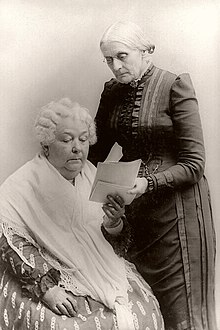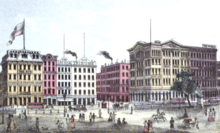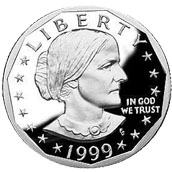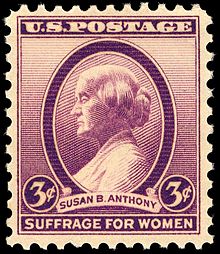 |
| Portrait of Susan B. Anthony that was used in the History of Woman Suffrage |
Today's Highlight in History:
1872 – Women's suffrage in the United States: In defiance of the law, suffragist Susan B. Anthony votes for the first time, and is later fined $100.
Susan Brownell Anthony (February 15, 1820 – March 13, 1906) was an American social reformer who played a pivotal role in the women's suffrage movement.
Born into a Quaker family, to Daniel Anthony and Lucy Read in Adams, Massachusetts, the second oldest of seven children. Anthony's father was an abolitionist and a temperance advocate. A Quaker, he had a difficult relationship with his traditionalist congregation, which rebuked him for marrying a non-Quaker.Their father encouraged them all, girls as well as boys, to be self-supporting, teaching them business principles and giving them responsibilities at an early age
Her family shared a passion for social reform. Her brothers Daniel and Merritt moved to Kansas to support the anti-slavery movement there. Merritt fought with John Brown against pro-slavery forces during the Bleeding Kansas crisis. Daniel eventually owned a newspaper and became mayor of Leavenworth. Anthony's sister Mary, with whom she shared a home in later years, became a public school principal in Rochester, and a woman's rights activist committed to social equality,
In 1851, she played a key role in organizing an anti-slavery convention in Rochester. She was also part of the Underground Railroad. An entry in her diary in 1861 read, "Fitted out a fugitive slave for Canada with the help of Harriet Tubman." In 1837, at age 16, Anthony collected petitions against slavery as part of organized resistance to the newly established gag rule that prohibited anti-slavery petitions in the U.S. House of Representatives.In 1856, she became the New York state agent for the American Anti-Slavery Society.
Anthony embarked on her career of social reform with energy and determination. Schooling herself in reform issues, she found herself drawn to the more radical ideas of people like William Lloyd Garrison, George Thompson and Elizabeth Cady Stanton. Soon she was wearing the controversial Bloomer dress, consisting of pantaloons worn under a knee-length dress. Although it was more sensible than the traditional heavy dresses that dragged the ground, she reluctantly quit wearing it after a year because it gave her opponents the opportunity to focus on her apparel rather than her ideas
When Anthony tried to speak at the New York State Teachers' Association meeting in 1853, her attempt sparked a half-hour debate among the men about whether it was proper for women to speak in public. Finally allowed to continue, Anthony said,
Her family shared a passion for social reform. Her brothers Daniel and Merritt moved to Kansas to support the anti-slavery movement there. Merritt fought with John Brown against pro-slavery forces during the Bleeding Kansas crisis. Daniel eventually owned a newspaper and became mayor of Leavenworth. Anthony's sister Mary, with whom she shared a home in later years, became a public school principal in Rochester, and a woman's rights activist committed to social equality,
In 1851, she played a key role in organizing an anti-slavery convention in Rochester. She was also part of the Underground Railroad. An entry in her diary in 1861 read, "Fitted out a fugitive slave for Canada with the help of Harriet Tubman." In 1837, at age 16, Anthony collected petitions against slavery as part of organized resistance to the newly established gag rule that prohibited anti-slavery petitions in the U.S. House of Representatives.In 1856, she became the New York state agent for the American Anti-Slavery Society.
Anthony embarked on her career of social reform with energy and determination. Schooling herself in reform issues, she found herself drawn to the more radical ideas of people like William Lloyd Garrison, George Thompson and Elizabeth Cady Stanton. Soon she was wearing the controversial Bloomer dress, consisting of pantaloons worn under a knee-length dress. Although it was more sensible than the traditional heavy dresses that dragged the ground, she reluctantly quit wearing it after a year because it gave her opponents the opportunity to focus on her apparel rather than her ideas
 |
| Headmistress Susan B. Anthony in 1848 at age 28 |
"Do you not see that so long as society says a woman is incompetent to be a lawyer, minister, or doctor, but has ample ability to be a teacher, that every man of you who chooses this profession tacitly acknowledges that he has no more brains than a woman."
At the 1857 teacher's convention, she introduced a resolution calling for the admission of black people to public schools and colleges, but it was rejected as "not a proper subject for discussion." When she introduced another resolution calling for males and females to be educated together at all levels, including colleges, it was fiercely opposed and decisively rejected. One opponent called the idea "a vast social evil... the first step in the school which seeks to abolish marriage, and behind this picture I see a monster of social deformity.
"In 1851, Anthony was introduced to Elizabeth Cady Stanton, who had been one of the organizers of the Seneca Falls Convention and had introduced the controversial resolution in support of women's suffrage. Anthony and Stanton soon became close friends and lifelong co-worker in social reform activities, primarily in the field of women's rights.The two women had complementary skills. Anthony excelled at organizing, while Stanton had an aptitude for intellectual matters and writing. Because Stanton was homebound with seven children while Anthony was unmarried and free to travel, Anthony assisted Stanton by supervising her children while Stanton wrote.
In 1852, they founded the New York Women's State Temperance Society after Anthony was prevented from speaking at a temperance conference because she was a woman. Temperance was very much a women's rights issue at that time because of laws that gave husbands complete control of the family and its finances. A woman with a drunken husband had little legal recourse even if his alcoholism left the family destitute and he was abusive to her and their children. Anthony and her co-workers collected 28,000 signatures on a petition for a law to prohibit the sale of alcohol in New York State. She organized a hearing on that law before the New York legislature, the first that had been initiated in that state by a group of women.
In 1872, Anthony was arrested for voting in her hometown of Rochester, New York, and Anthony and nearly fifty other women in Rochester attempted to vote in the presidential election of 1872. Fifteen of them convinced the election inspectors to allow them to cast ballots, but the others were turned back. When Anthony voted, however, the reaction was different, and her case became a national controversy.Anthony was arrested on November 18, 1872, by a U.S. Deputy Marshal and charged with illegally voting. The other fourteen women were also arrested but released pending the outcome of Anthony's trial In 1878, Anthony's trial was a major step in the transition of the women's rights movement into the women's suffrage movement. The trial began on July 17, 1873, and was closely followed by the national press. she was convicted and asked to pay a fine of $100, Although she refused to pay the fine, the authorities declined to take further action.
 |
| Elizabeth Cady Stanton (sitting) with Anthony |
 |
| Susan B. Anthony |
In 1872, Anthony was arrested for voting in her hometown of Rochester, New York, and Anthony and nearly fifty other women in Rochester attempted to vote in the presidential election of 1872. Fifteen of them convinced the election inspectors to allow them to cast ballots, but the others were turned back. When Anthony voted, however, the reaction was different, and her case became a national controversy.Anthony was arrested on November 18, 1872, by a U.S. Deputy Marshal and charged with illegally voting. The other fourteen women were also arrested but released pending the outcome of Anthony's trial In 1878, Anthony's trial was a major step in the transition of the women's rights movement into the women's suffrage movement. The trial began on July 17, 1873, and was closely followed by the national press. she was convicted and asked to pay a fine of $100, Although she refused to pay the fine, the authorities declined to take further action.
They founded the Women's Loyal National League, which conducted the largest petition drive in the nation's history up to that time, collecting nearly 400,000 signatures in support of the abolition of slavery. In 1866, they initiated the American Equal Rights Association, which campaigned for equal rights for both women and African Americans. Anthony and Stanton arranged for Congress to be presented with an amendment giving women the right to vote. Popularly known as the Anthony Amendment, it became the Nineteenth Amendment to the U.S. Constitution in 1920.
Anthony and Stanton began publishing a weekly newspaper called The Revolution in New York City in 1868. It focused primarily on women's rights, especially suffrage for women, but it also covered other topics, including politics, the labor movement and finance. One of its goals was to provide a forum in which women could exchange opinions on key issues from a variety of viewpoints. Anthony managed the business aspects of the paper while Stanton was co-editor along with Parker Pillsbury, an abolitionist and a supporter of women's rights. Initial funding was provided by George Francis Train, the controversial businessman who supported women's rights but who alienated many activists with his political and racial views.
In 1869, they founded the National Woman Suffrage Association as part of a split in the women's movement. In 1890 the split was formally healed when their organization merged with the rival American Woman Suffrage Association to form the National American Woman Suffrage Association, with Anthony as its key force. In 1876, Anthony and Stanton began working with Matilda Joslyn Gage on what eventually grew into the six-volume History of Woman Suffrage. The interests of Anthony and Stanton diverged somewhat in later years, but the two remained close friends.
Anthony and Stanton began publishing a weekly newspaper called The Revolution in New York City in 1868. It focused primarily on women's rights, especially suffrage for women, but it also covered other topics, including politics, the labor movement and finance. One of its goals was to provide a forum in which women could exchange opinions on key issues from a variety of viewpoints. Anthony managed the business aspects of the paper while Stanton was co-editor along with Parker Pillsbury, an abolitionist and a supporter of women's rights. Initial funding was provided by George Francis Train, the controversial businessman who supported women's rights but who alienated many activists with his political and racial views.
 |
| Printing House Square in Manhattan in 1868, showing the sign for The Revolution's office at the far right below The World and aboveScientific American. |
In 1869, they founded the National Woman Suffrage Association as part of a split in the women's movement. In 1890 the split was formally healed when their organization merged with the rival American Woman Suffrage Association to form the National American Woman Suffrage Association, with Anthony as its key force. In 1876, Anthony and Stanton began working with Matilda Joslyn Gage on what eventually grew into the six-volume History of Woman Suffrage. The interests of Anthony and Stanton diverged somewhat in later years, but the two remained close friends.
Their interests began to diverge somewhat as they grew older. As the drive for women's suffrage gained momentum, Anthony began to form alliances with more conservative groups, such as the Women's Christian Temperance Union, the nation's largest women's organization and a supporter of women's suffrage. Such moves irritated Stanton, who said, "I get more radical as I get older, while she seems to grow more conservative." In 1895 Stanton published The Woman's Bible, which attacked the use of the bible to relegate women to an inferior status. It became a highly controversial best-seller. The NAWSA voted to disavow any connection with it despite Anthony's strong objection that such a move was unnecessary and hurtful. Even so, Anthony refused to assist with the book's preparation, telling Stanton: "You say 'women must be emancipated from their superstitions before enfranchisement will have any benefit,' and I say just the reverse, that women must be enfranchised before they can be emancipated from their superstitions."Despite such friction, their relationship continued to be close until Stanton death in 1902,
Anthony traveled extensively in support of women's suffrage, giving as many as 75 to 100 speeches per year and working on many state campaigns. She worked internationally for women's rights, playing a key role in creating the International Council of Women, which is still active. She also helped to bring about the World's Congress of Representative Women at the World's Columbian Exposition in Chicago in 1893.
When she first began campaigning for women's rights, Anthony was harshly ridiculed and accused of trying to destroy the institution of marriage. Public perception of her changed radically during her lifetime. During the six remaining years of her life, Anthony spoke at six more NAWSA conventions and four congressional hearings, completed the fourth volume of the History of Woman Suffrage, and traveled to eighteen states and to Europe. As Anthony's fame grew, some politicians (certainly not all of them) were happy to be publicly associated with her. Her seventieth birthday was celebrated at a national event in Washington with prominent members of the House and Senate in attendance.Her eightieth birthday was celebrated at the White House at the invitation of President William McKinley
She became the first non-fictitious woman to be depicted on U.S. currency when her portrait appeared on the 1979 dollar coin.
When she first began campaigning for women's rights, Anthony was harshly ridiculed and accused of trying to destroy the institution of marriage. Public perception of her changed radically during her lifetime. During the six remaining years of her life, Anthony spoke at six more NAWSA conventions and four congressional hearings, completed the fourth volume of the History of Woman Suffrage, and traveled to eighteen states and to Europe. As Anthony's fame grew, some politicians (certainly not all of them) were happy to be publicly associated with her. Her seventieth birthday was celebrated at a national event in Washington with prominent members of the House and Senate in attendance.Her eightieth birthday was celebrated at the White House at the invitation of President William McKinley
 |
| U.S. dollar coin with image of Susan. B. Anthony |
 |
commemorative stamp, 1936 issueIssued allowing women to vote. |
Susan B. Anthony died at the age of 86 of heart failure and pneumonia in her home in Rochester, New York, on March 13, 1906. She was buried at Mount Hope Cemetery, Rochester.
Anthony did not live to see the achievement of women's suffrage at the national level, but she was proud of the progress the women's movement had made. At the time of her death, women had achieved suffrage in Wyoming, Utah, Colorado and Idaho, and several larger states followed soon after. Legal rights for married women had been established in most states, and most professions had at least a few women members. 36,000 women were attending colleges and universities, up from zero a few decades earlier." Two years before she died, Anthony said, "The world has never witnessed a greater revolution than in the sphere of woman during this fifty years".
Anthony did not live to see the achievement of women's suffrage at the national level, but she was proud of the progress the women's movement had made. At the time of her death, women had achieved suffrage in Wyoming, Utah, Colorado and Idaho, and several larger states followed soon after. Legal rights for married women had been established in most states, and most professions had at least a few women members. 36,000 women were attending colleges and universities, up from zero a few decades earlier." Two years before she died, Anthony said, "The world has never witnessed a greater revolution than in the sphere of woman during this fifty years".
Legacy
Anthony's home in Rochester is now a National Historic Landmark called the National Susan B. Anthony Museum and House. The house of her birth in Adams, Massachusetts, and her childhood home in Battenville, New York, are listed on the National Register of Historic Places.
The rotunda of the U.S. Capitol contains a statue that honors three leading women's rights leaders: Anthony, Elizabeth Cady Stanton, and Lucretia Mott. The Cathedral of St. John the Divine in Manhattan, one of the world's largest, has a sculpture honoring four spiritual heroes of the twentieth century: Anthony, Martin Luther King, Albert Einstein, and Mohandas Gandhi.
In 1936, the U.S. Post Office issued its first postage stamp honoring Susan B. Anthony. A second stamp honoring Anthony was issued in April 1958.
In 1979, the United States Mint began issuing the Susan B. Anthony dollar coin, the first U.S. coin to honor a real woman rather than an allegorical female figure.The Nineteenth Amendment, which guaranteed the right of women to vote, was popularly known as the Susan B. Anthony Amendment. After it was ratified in 1920, the National American Woman Suffrage Association, whose character and policies were strongly influenced by Anthony, was transformed into the League of Women Voters, which is still an active force in U.S. politics.
wikipedia
1831 – Nat Turner, American slave leader, is tried, convicted, and sentenced to death in Virginia.
1872 – Women's suffrage in the United States: In defiance of the law, suffragist Susan B. Anthony votes for the first time, and is later fined $100.
1895 – George B. Selden is granted the first U.S. patent for an automobile.
1912 – Woodrow Wilson is elected to the presidency of the United States.
1916 – The Kingdom of Poland is proclaimed by the Act of November 5th of the emperors of Germany and Austria-Hungary.
1917 – St. Tikhon of Moscow is elected the Patriarch of Moscow and of the Russian Orthodox Church.
1925 – Secret agent Sidney Reilly, the first "super-spy" of the 20th century, is executed by the OGPU, the secret police of the Soviet Union.
1937 – Adolf Hitler holds a secret meeting and states his plans for acquiring "living space" for the German people.
2006 – Saddam Hussein, former president of Iraq, and his co-defendants Barzan Ibrahim al-Tikriti and Awad Hamed al-Bandar are sentenced to death in the al-Dujail trial for the role in the massacre of the 148 Shi'a Muslims in 1982
2007 – China's first lunar satellite, Chang'e 1 goes into orbit around the Moon.
2007 – Android mobile operating system is unveiled by Google.
2009 – U.S. Army Major Nidal Malik Hasan murders 13 and wounds 32 at Fort Hood, Texas in the deadliest mass shooting at a U.S. military installation.
2013 – India launches the Mars Orbiter Mission, its first interplanetary probe.
Anthony's home in Rochester is now a National Historic Landmark called the National Susan B. Anthony Museum and House. The house of her birth in Adams, Massachusetts, and her childhood home in Battenville, New York, are listed on the National Register of Historic Places.
The rotunda of the U.S. Capitol contains a statue that honors three leading women's rights leaders: Anthony, Elizabeth Cady Stanton, and Lucretia Mott. The Cathedral of St. John the Divine in Manhattan, one of the world's largest, has a sculpture honoring four spiritual heroes of the twentieth century: Anthony, Martin Luther King, Albert Einstein, and Mohandas Gandhi.
In 1936, the U.S. Post Office issued its first postage stamp honoring Susan B. Anthony. A second stamp honoring Anthony was issued in April 1958.
In 1979, the United States Mint began issuing the Susan B. Anthony dollar coin, the first U.S. coin to honor a real woman rather than an allegorical female figure.The Nineteenth Amendment, which guaranteed the right of women to vote, was popularly known as the Susan B. Anthony Amendment. After it was ratified in 1920, the National American Woman Suffrage Association, whose character and policies were strongly influenced by Anthony, was transformed into the League of Women Voters, which is still an active force in U.S. politics.
wikipedia
World Events
1831 – Nat Turner, American slave leader, is tried, convicted, and sentenced to death in Virginia.
1872 – Women's suffrage in the United States: In defiance of the law, suffragist Susan B. Anthony votes for the first time, and is later fined $100.
1895 – George B. Selden is granted the first U.S. patent for an automobile.
1912 – Woodrow Wilson is elected to the presidency of the United States.
1916 – The Kingdom of Poland is proclaimed by the Act of November 5th of the emperors of Germany and Austria-Hungary.
1917 – St. Tikhon of Moscow is elected the Patriarch of Moscow and of the Russian Orthodox Church.
1925 – Secret agent Sidney Reilly, the first "super-spy" of the 20th century, is executed by the OGPU, the secret police of the Soviet Union.
1937 – Adolf Hitler holds a secret meeting and states his plans for acquiring "living space" for the German people.
2006 – Saddam Hussein, former president of Iraq, and his co-defendants Barzan Ibrahim al-Tikriti and Awad Hamed al-Bandar are sentenced to death in the al-Dujail trial for the role in the massacre of the 148 Shi'a Muslims in 1982
2007 – China's first lunar satellite, Chang'e 1 goes into orbit around the Moon.
2007 – Android mobile operating system is unveiled by Google.
2009 – U.S. Army Major Nidal Malik Hasan murders 13 and wounds 32 at Fort Hood, Texas in the deadliest mass shooting at a U.S. military installation.
2013 – India launches the Mars Orbiter Mission, its first interplanetary probe.


No comments:
Post a Comment